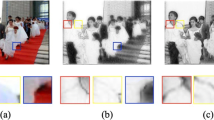Abstract
We present a system for drawing pastel media in real-time as an effective alternative to most existing digital solutions that basically allow for drawing arbitrary strokes in a particular style. Our approach is focused on the simulation of the natural material itself and on its interaction with the drawing surface and the drawing tool.
Upon free-form drawing, a bidirectional transfer of pigment takes place. In one direction, the paper surface is dusted with new pigment particles broken off the tip (i.e., the end of the drawing tool). A large part of these particles will be deposited or blended together with previously deposited ones whereas the remainder does not contribute to the drawing and is blown off. On the other hand, a certain amount of previously deposited pigment is scraped off and picked up again soiling the tip. This is noticeable in the next strokes to be drawn. Furthermore, both the tip and the paper surface are subject to weathering depending on the exerted pressure and friction of the drawing tool, and the bumpiness of the paper. As a result, the paper surface becomes slightly damaged, limiting the deposition of new pigment. The tip, on the other hand, becomes blunt making new strokes wider.
From a stylistic point of view, similarly to traditional drawings our results convey the artists’ characteristics (e.g., the way of wielding the brush, skillfulness, feeling for the medium). Therefore, we believe that our system allows an artist to create realistically looking pastel images without losing his/her personal touch.
Similar content being viewed by others
Explore related subjects
Discover the latest articles, news and stories from top researchers in related subjects.References
Gooch, B., Gooch, A.A.: Non-Photorealistic Rendering. AK Peters, Wellesley, MA (2001). (ISBN: 1568811330)
Hebborn, E.: The Art Forger’s Handbook, reprint edn. Penguin, New York (2004)
Kubelka, P., Munk, F.: Ein Beitrag zur Optik der Farbanstriche. Z. Tech. Phys. 12 (1931)
Mudde, C.: Pastel. Cantecleer, De Bilt, Baarn, The Netherlands (2003)
Murakami, K., Tsuruno, R., Genda, E.: Multiple illuminated paper textures for drawing strokes. In: Proceedings of Computer Graphics International (CGI2005), pp. 156–161. IEEE (2005)
Murakami, K., Tsuruno, R., Genda, E.: Natural-looking strokes for drawing applications. Visual Comput. 22(6), 415–423 (2006)
Reynolds, C.: Stylized depiction in computer graphics. World Wide Web, URL http://www.red3d.com/cwr/npr/ (2004)
Rudolf, D., Mould, D., Neufeld, E.: Simulating wax crayons. In: Proceedings of Pacific Conference on Computer Graphics and Applications (Pacific Graphics 2003), pp. 163–172. IEEE Computer Society, Washington, DC (2003)
Rudolf, D., Mould, D., Neufeld, E.: A bidirectional deposition model of wax crayons. Comput. Graph. Forum 24(1), 27–40 (2005)
Strothotte, T., Schlechtweg, S.: Non-Photorealistic Computer Graphics. Modeling, Rendering, and Animation. Morgan Kaufmann, San Francisco, CA (2002) ISBN: 1-55860-787-0
Worley, S.: A cellular texture basis function. In: Proceedings of the 23rd Annual Conference on Computer Graphics and Interactive Techniques, pp. 291–294. ACM Press, New York (1996)
Author information
Authors and Affiliations
Corresponding author
Rights and permissions
About this article
Cite this article
Van Haevre, W., Van Laerhoven, T., Di Fiore, F. et al. From dust till drawn. Visual Comput 23, 925–934 (2007). https://doi.org/10.1007/s00371-007-0144-5
Published:
Issue Date:
DOI: https://doi.org/10.1007/s00371-007-0144-5




